IN THE LATE 1930s AND EARLY 1940s, DALLAS WORKERS FOR THE WRITERS’ Program of the Work Projects Administration compiled The WPA Dallas Guide and History, a comprehensive history and general tour of the city. Certainly, the landscape of Dallas-both real and metaphoric- has changed, yet the authors’ synopsis still holds true more than half a century later: “Its very lack of indigenous features gives it a certain character peculiar to itself…. Its setting and climate are Southern; its purposeful, high pressure-activity and solid enterprise are Northern; its sophistication and modishness Eastern; and its civic pride and youthful, confident spirit, delighting in newness and bigness for their own sake, Western.”
Though it may sound trite, Dallas truly is all things to everyone: a cosmopolitan center surrounded by sprawling suburbs; rustic ranches and massive marsions; a sports-crazed town with world-class culture. Each neighborhood, distinct though hard to define, contributes to the area’s overall appeal. Dallas has everything to offer if you just know where to look.
DOWNTOWN
Of course in the center of it all is downtown and its stgnatare skyline, distinctive ever since the Peg; sus graced the lop of the Magnolia Building in 1934 to welcome delegates to an oil convention. It began to be overshadowed in 1 lie 1950s as taller buildings rose from the flat Texas plains. The most identifiable of these skyscrapers blossomed in 1978, the Reunion Tower ball, but other structures are apt to catch one’s eye: Renaissance Tower (the one with the lighted “x”), NationsBank (the green ont ), and the Texas Commerce Building (the one with the hole in it).
World-renwned architect I.M. Pei has done his part |o shape the downtown horizon. In 197X, Pei’s new city hall opened after 12 years in the making. Pei’s design of the building was Complimented, as well as its philosophy ar|d symbolism of strength and simplicity.
Downtown Is more than tall buildings. There’s, of course, history: the famed grassy knoll rests quietly beneath the Texas Schoolbook Depository, site of the Sixth Floor Museum, a somber retrospective of the life and death of John F. Kennedy. For an unofficial explanation of the events on November 22, 1963. there’s The Conspiracy Museum, which exposes alleged coverups.
Downtown there are also surprises, like fresh produce year-round at the Farmers Midfeet Covering 12 acres, the downtown market is the largest municipally operated farmers market in the country.
Thanks-Giving Square is also tucked away among the city’s skyscrapers. Designed by Philip Johnson, the chapel, with its spiraling spire, is a nondenominational site of worship, providing spirituality amidst the hustle and bustle of commerce.
And there’s also a recent resurgence of retail and residential vibrance downtown, notably in the renovated Titche’s Building. But then there’s always been great shopping downtown at the original Neiman Marcus.
WEST END
On the west end of downtown is, appropriately enough, the West End. Designated as a historical district in 1975, it has become a tourists’ haven for dining, shopping, and entertainment, especially at the Marketplace: 10 stories of antiques, souvenir shops, food vendors, and a 10-screen movie theater. Festivals and events regularly fill the streets, and in the winter, an outdoor ice rink defies Texas weather. Dallas Alley is where most of the nightlife here is concentrated.
DEEP ELLUM
To the east of downtown is an area with deeper roots. Deep Ellum. Since the end of the 19th century, displaced A Mean-Americans established a vibrant community around the intersection of Central Avenue and Elm Street, the growth of which was enhanced by the nearby terminals of the town’s first railroad in 1872. The area developed a reputation of hard living and wild nightlife, both praised and lamented by such blues musicians as Huddie “Leadbelly” Ledbetter and Blind Lemon Jefferson. Today, Deep Ellum is still the place to go for live music, tattoos, eclectic shopping, good food, and wild nightlife.
ARTS DISTRICT
On the north edge of downtown, the Ans District continues to grow. In 1983. the city council approved creation of the Arts District on a 60-acre tract of land along Ross Avenue. The Dallas Museum of Art, which opened to high praise in 1984, was the first occupant. The DMA houses one of the best collections of pre-Columbian art in the country as well as excellent rotating exhibits.
The Arts District received a momentous boost when Raymond Nasher selected Dallas as the display site for his $32 million garden of outdoor modern masterpieces, currently in the planning phase.
In 1989, the Morton H. Meyerson Symphony Center was completed and immediately revered as one of the finest concert facilities in the world. Nearly one quarter of the $81.5 million cost of building the symphony center was donated by H. Ross Perol, who stipulated that it would be designed by l.M. Pei and thai the concert hall would be named after Perot’s friend and longtime business associate.
UPTOWN AND OAK LAWN
Though historic and sometimes quaint, Uptown has become synonymous with trendi-ness, trolleys, and the Hard Rock Cafe. What the Upper East Side is to New York. Uptown is to Dallas.
But that’s according to critics. Uptown offers several antiques shops and art galleries, the McKinney Avenue Contemporary, and Theatre Three in The Quadrangle, which puts on a range of productions from fresh to classic. And there’s no shortage of nightlife.
Uptown blends into Oak Lawn, which in many respects is more of the same: nice shops, great food. Oak Lawn is the community that a large percentage of the city’s gay population calls home.
KNOX-HENDERSON
Travel further north on McKinney and you’ll find yourself in Knox-Henderson, the new retail place-to-be. The street’s name represents the split-personality nature of the area. To the east of Central Expressway, it’s Henderson, with its eclectic mix of galleries, antiques shops, bars, and restaurants. To the west, it becomes Knox, and the shopping becomes a bit more upscale and much more concentrated with home furnishings. It’s a nice neighborhood to walk around, shop, and dine.
HIGHLAND AND UNIVERSITY PARK
Just as Uptown is Upper East Side, Highland Park is Beverly Hills. Palacial, historic homes are worth a Sunday drive, preferably in a luxury car so you don’t feel out of place. The Beverly Hills reference is not mere opinion. Highland Park was developed in 1907 as an exclusive community planned by landscape architect Wilbur David Cook, who had previously designed Beverly Hills. In addition. Highland Park Village offers shopping worthy of Rodeo Drive.
University Park is the other half of the Park Cities. The two suburbs have been urged as far back as 1917 to become a part of Dallas, but they prefer their independence. University Park developed around Southern Methodist University. The campus opened in 1915 with a main building, Dallas Hall, that still stands and provides a great view of downtown on a clear day. On the western outskirts of University Park is the Inwood Village, a shopping block of boutiques.
PRESTON HOLLOW
Further north is Preston Hollow. In 1945, whereas people in the Park Cities opposed annexation, Preston Hollow residents favored unification and became part of Dallas. Preston Hollow, with its country-lane feel, serves as the heart of Dallas’ Golden Corridor, featuring some of the city’s most luxurious older homes as well as some of the newer mansions.
NorthPark Center is a veritable shopping mecca. Conceived and developed by Raymond Nasher, the nation’s first upscale covered mall opened in 1965. NorthPark is more than a mall, and more than shopping goes on: There’s prime people-watching; there are exercisers on their daily walks (a one-way jaunt from one end of the horseshoe-shaped mall to the other is half a mile); and there are rotations of Nasher’s 20th-century art collection.
ADDISON
Settlers attached the name Peters Colony to the large chunk of North Texas that they founded in 1846. In 1902, part of that area became Addison, officially incorporated in 1953. Anchored on the north by Addison Airport and on the south by Spring Valley Road, the little town in a big city measures 4’A square miles, yet there are 10 hotels and more than 100 restaurants, most of which are concentrated on Belt Line Road.
While Addison is Dallas’ dining purlieu, eating is not the only activity there. Appreciate fine productions at the WaterTower Theater or catch comedy at Addison Improv. The Cavanaugh Flight Museum features 50,000 square feet of warbirds on display restored to their original condition.
LOWER GREENVILLE
The singles scene of the “70s still lingers at Lower Greenville, continually attracting new generations of denizens. Typically, singles migrate from The Village, a high-concentration of apartments around Greenville Avenue and Lovers Lane, and move south into quaint houses on the M Streets-McCommas, Monticello, Mercedes, et al. But at night, they all head south on Greenville, where it’s often too easy to find a place to drink.
FAIR PARK
Though some people in Miami may argue, Fair Park is the largest assemblage of art deco architecture in the country, with 227 acres of distinctive design. Built for the 1936 Texas Centennial Celebration, the buildings themselves are noteworthy, let alone what’s inside: the Science Place, the African American Museum, the Hall of State, the Museum of Natural History, and more.
LAKEWOOD
Natural beauty has survived in Dallas. White Rock Lake, a man-made lake that was the city’s principal reserve water supply until the creation of Lake Dallas, is surrounded by the woodland area of White Rock Lake Park, a nice spot for walking, jogging, riding, or rollerblading. For Edenic beauty, check out the Dallas Arboretum and Botanical Garden.
LAS COLINAS
A winding canal adds shades of Venice to this varied area. Enjoy golf at the Four Seasons Resort. Appreciate performances at the Irving Arts Center. Eat well at numerous restaurants. Witness movie magic at the Studios of Las Colinas. And be awed by the Mustang Sculpture Exhibit in Williams Square.
ARLINGTON
Like an amusement oasis between Dallas and Fort Worth, Arlington’s Entertainment District stretches along Interstate 30. The first “tourist” attraction in Arlington, of course, was Six Flags Over Texas, opened 35 years ago by Angus Wynne Jr.
The Entertainment District’s crown jewel is The Ballpark in Arlington, built in 1994 as the new home for the Texas Rangers. A first-class facility funded largely by a sales-tax increase, The Ballpark was built with visitors-and marketing-in mind. You can tour The Ballpark year-round, visit the Legends of the Game Museum, or eat at two restaurants that overlook the park.
A third entertainment anchor in the area is Six Flags Hurricane Harbor (formerly Wet ’n Wild), a water park perfect for those Texas summer scorchers.
Just east of this cluster is the newest addition, Lone Star Park, which brings the excitement of horseracing to the area. Annually, there is a spring season of thoroughbred racing, a fall season of quarterhorse and thoroughbreds, and simulcasts of horseraces from all over the country year-round.
FORT WORTH
STOCKYARDS
This is what you want Texas to be. The city’s best-known historical landmark, the yards were a destination for cattle drives like the one made famous in Lonesome Dove. When railroads arrived in 1876, Fort Worth became a major shipping point to Eastern meat markets. The Visitors Information Center will help orient you, or you can walk along Exchange Avenue straight back in time into living Western history.
THE CULTURAL DISTRICT
Fort Worth’s “cowboys and culture” combination finds its best illustration in this area. Every January, the Fort Worth Stock Show and Rodeo that is held at Will Rogers Coliseum brings real cowboys and all sorts of livestock in comfortable proximity to museums housing some of the world’s greatest art.
The Kimbell Art Museum has an excellent collection of European and Asian art and is home to many blockbuster traveling exhibits. The recently renovated Amon Carter Museum of Western Art houses former Fort Worth Star-Telegram publisher Amon Carter’s famous collection. The Modern Art Museum of Fort Worth boasts American and European contemporary art and a new collection of international photography. The Fort Worth Museum of Science and Natural History features excellent exhibits on Texas’ natural history, as well as the exciting Omni Theater and the Noble Planetarium. All the museums are within easy walking distance of one another.
Immediately south of the Cultural District is the Fort Worth Zoo. Within the Botanic Gardens and Conservatory are the Japanese Gardens, considered to be some of the finest in the country.
SUNDANCE SQUARE-DOWNTOWN FORT WORTH
This restored area of downtown Fort Worth sits just a few blocks south of the bluff overlooking the Trinity River where the original city of Fort Worth was established in ! 849. A very walkable area, its blocks are filled with opportunities to visit numerous museums and collections, sample a play, see a musical, dine in style, and enjoy the nightlife. Sundance is both historical and revitalized at the same time-just as the Dallas-Fort Worth area.
Get our weekly recap
Brings new meaning to the phrase Sunday Funday. No spam, ever.
Related Articles

Healthcare
Dallas’ Breakthrough Blood Test for Cancer
With just 40ml of blood, Cancer Check Labs can test for the presence of more than 200 solid tumors.
By Will Maddox

News
Medical City Opens ER in Garland and Local Dermatologist Named Youngest Ever President of the American Academy of Dermatology
Plus Health Wildcatters wins accelerator competition and DFW Hospital Council Foundation awards.
By Bridget Reis

Business
Wicked Bold Chocolate CEO and Comedian Deric Cahill on Why it Pays to Be Funny
The brand leans into humor, but the business' success is no laughing matter, with products in nearly 2,000 retail locations nationwide.
By Will Maddox


